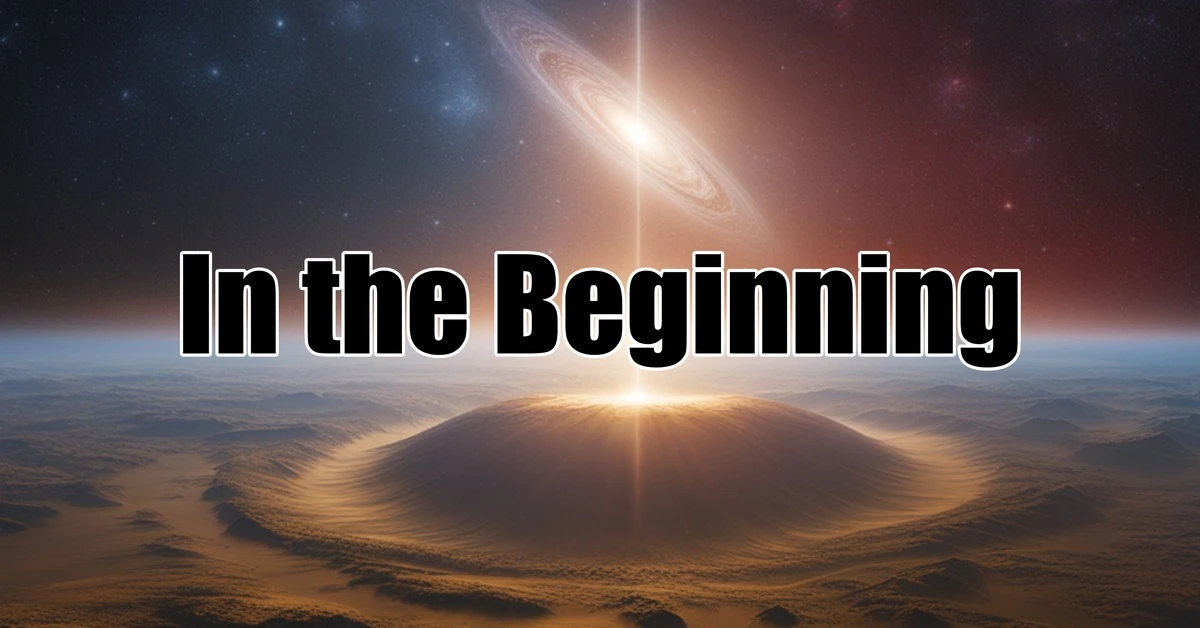In the beginning, God created the heavens and the earth. The earth was without form and void, and darkness was over the face of the deep. And the Spirit of God was hovering over the face of the waters.
And God said, “Let there be light,” and there was light. And God saw that the light was good. And God separated the light from the darkness. God called the light Day, and the darkness he called Night. And there was evening and there was morning, the first day.
Understanding And Applying the Text
The creation account is the foundation of Israel’s worldview. It is how Israel understood God, human beings, the world, and the laws about man.
In the beginning… Moses asserted that the world had not started to be well-formed. God created. That is it did not exist. The world was made. God made it. God did not form it. He created it. Moses refutes the idea matter always existed. God created it ex nihilo. How? I don’t know. Moses does not tell us. We only know who, not how.
Moses uses the term “Elohim.” This is a plural. It is easy to conclude that this is a reference to the Trinity. While this is a possible inference. It is not a necessary inference. Many have used this to prove the divinity of Christ. But in doing so they can fall prey to another heresy. That is the error of Sabellius. Moses says “Elohim” spoke. If we claim three persons here, there is no distinction between them. That is not the doctrine of the Trinity. The Son is God. That Father is God. And the Spirit is God. But they are distinct persons. The Son is not the Father. The Spirit is not the Father. The Son is not the Spirit. Three in person. One in essence.
The plural expresses the power and majesty of God. Moses referred to God in the majestic plural as we may refer to an earthly king in the plural. It is the royal “we.”
Moses breaks creation into 6 days or steps or phases. Why? Why didn’t God create everything all at once? We don’t know. The scripture does not tell us. And as Luther said where the scriptures do not speak I will cease my inquiry. (It may have been Calvin. I have heard it attributed to both)
The earth was without form and void. Here Moses says the world/universe was chaotic. Then he adds, “and darkness was on the face of the deep.” This creates an image of total confusion. That is why Moses refers to it as waters. It had no form in itself. There was nothing stable or solid.
Then the Spirit of God moved over this unstable mass. He gave it form and structure. In doing so He removed the confusion and instability. In the new heaven and new earth, there will be no sea or darkness (Revelations 21:1, 25)
In verse 3 Moses introduces God acting by speaking. Until now it is as if God created the heavens and earth without a word. God said, “Let there be light.” Here the skeptic mocks. God created light but there was no sun. there was no moon. But here they let their prejudice overrun their logic. The sun and moon do not create light they produce light. There is a difference. You cannot produce something that does not already exist. An example of this is how a magician produces a coin. He makes a coin appear in his hand. He did not create the coin. He produced it. The coin preexisted his producing it. While this is not an exact correlation. It does illustrate the difference between producing something and creating it. It is clear from the context, that light was so created to oppose darkness. The Hebrew here is also translated as “set apart.” Separation is fundamental both to creation and to Israel’s existence (3:15; 4:1–17; 12:1; Lev. 20:24, 25; Num. 8:14).
In ancient times one demonstrated authority over something by naming it. If you had the authority or power to name something, you had authority or power over it. Here God names day and night. He rules over all.
Scholars have proposed several interpretations of the creative “day.” Some view these as literal, 24-hour days. This interpretation usually entails the view that the earth is relatively “young” (c. 10,000 years old or less). Others note the Hebrew word for “day” (yom) can refer to time periods (e.g., 2:4). They propose the “day-age theory,” that the creative “days” refer to extended ages or epochs of time. Others hold the days are literal, 24-hour days but extended time periods separate them. Finally, some argue that the “days” of creation constitute a literary framework (vv. 3–31 note) designed to teach that God alone is the creator of an orderly universe. This is the “framework hypothesis.” It views the days of creation as God’s accommodating the limitations of human knowledge.
Most readers will find my view unsatisfactory. I call it a Genesis 5 view of creation. That is I hold to the first five words of Genesis. “In the beginning God created…” That is what is being conveyed. To go beyond that is to delve into areas that God has not revealed in His special revelation.
If you want to hold to a 24-hour day that is fine. If you want to a day-age theory. That is fine. If you want to hold to a framework theory. That is fine. The key is, “In the beginning God created.” That is there was a beginning and God created all that is. Except for Himself obviously.


Leave a Reply